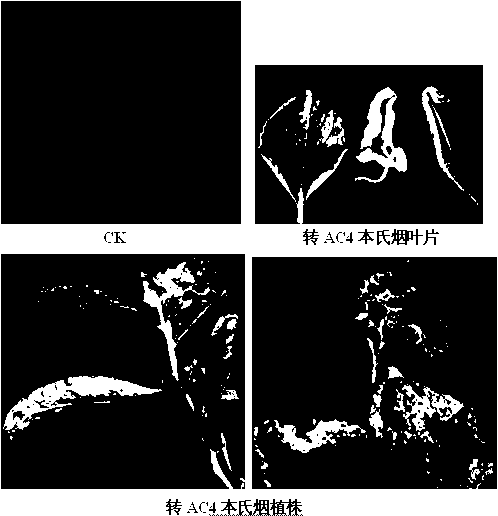Isolation and identification of Yunnan tomato leaf curl viral genome and agrobacterium tumefaciens-mediated infective clone construction
An Agrobacterium-mediated, tomato koji technology, applied in genetic engineering, plant genetic improvement, microbial assay/inspection, etc., can solve problems such as affecting the efficiency of gemini virus inoculation, reducing experimental efficiency, and tedious operation steps. Large-scale promotion, easy operation, good repeatability
- Summary
- Abstract
- Description
- Claims
- Application Information
AI Technical Summary
Problems solved by technology
Method used
Image
Examples
Embodiment 1
[0039] Example 1 Cloning and determination of Yunnan tomato leaf curl virus Y194 genome DNA
[0040] 1) Extraction of total plant DNA
[0041] Weigh 0.5-1.0 g of Yunnan tomato leaf curl virus-infected leaves in the field, add liquid nitrogen and grind to powder, quickly transfer the ground powder into 50 ml and add 4-8 ml of CTAB extract [containing 2% (v / v) 2-Mercaptoethanol (2-Me)] in a centrifuge tube. Heat in a water bath at 65°C, mix by inverting every 20-30 minutes, add an equal volume of 24:1 chloroform / isoamyl alcohol after 1 hour, mix by inverting up and down, and centrifuge at 10,000 rpm at 4°C for 5 minutes. Transfer the supernatant to another new 50 ml centrifuge tube, add 1 / 10 of the supernatant volume CTAB / NaCl and an equal volume of 24:1 chloroform / isoamyl alcohol, mix well, and centrifuge at 10,000 rpm at 4°C 5 min. Transfer the supernatant to another new 50 ml centrifuge tube, add 1 / 10 supernatant volume of 3 M NaAc (pH 5.2) and an equal volume of -20°C ...
Embodiment 2
[0044] Example 2 Construction of Infectious Clone of Yunnan Tomato Leaf Curl Virus Y194
[0045] Agrobacterium-mediated invasive cloning of geminivirus requires a full-length genome with more than 1.3-2.0 repeats and must include 2 intergenic regions (IR regions). Using viral genomic DNA as a template to contain Eco Y194EF (5'- GCGGAATTCCTTAAAGTGCTTTAG -3') and Y194ER (5'- TAGGAATTCATGGGAGCCCAAAG -3') at the R I single restriction site were used as primers, amplified by PCR and cloned into pGEM-T Vector to obtain pGEM-T-Y194, using Bam H I and Eco R I digested pGEM-T-Y194 to obtain 0.4 full-length DNA for insertion Bam H I and Eco The binary vector pBinPLUS obtained by R I double enzyme digestion was pBinPLUS-Y194-0.4A; Eco R I cut out a complete full-length DNA from pGEM-T-Y194 and inserted it into the corresponding site of pBinPLUS-Y194-0.4A to obtain an invasive clone of pBinPLUS-Y194-1.4A.
Embodiment 3
[0046] Example 3 Transformation of Agrobacterium by electric shock with recombinant vector
[0047] The recombinant plant expression vector was introduced into the Agrobacterium host cell EHA105 by electric shock. First, the competent cells of EHA105 need to be prepared. Pick a single colony of Agrobacterium EHA105 and inoculate it in 5 mL of YEP liquid medium containing 40 μg / mL rifampicin (Rif), culture at 28°C and 200 rpm until OD600≈0.6, collect enough bacteria with a 1.5 mL centrifuge tube, Centrifuge at 8,000 rpm at 4°C for 1 min, discard the supernatant; use 200 μL ddH 2 O was fully resuspended, centrifuged at 8,000 rpm at 4°C for 1 min, and the supernatant was discarded. After repeating three times, the supernatant was discarded; 2 O Sufficiently resuspended, namely Agrobacterium competent cells. Take 10 μL of the recombinant plasmid pBinPLUS-Y194-1.4A and add it to 200 μL of Agrobacterium tumefaciens competent cells, mix gently, transfer to an electric shock cup,...
PUM
 Login to View More
Login to View More Abstract
Description
Claims
Application Information
 Login to View More
Login to View More - Generate Ideas
- Intellectual Property
- Life Sciences
- Materials
- Tech Scout
- Unparalleled Data Quality
- Higher Quality Content
- 60% Fewer Hallucinations
Browse by: Latest US Patents, China's latest patents, Technical Efficacy Thesaurus, Application Domain, Technology Topic, Popular Technical Reports.
© 2025 PatSnap. All rights reserved.Legal|Privacy policy|Modern Slavery Act Transparency Statement|Sitemap|About US| Contact US: help@patsnap.com


